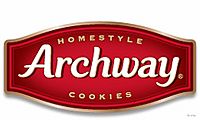Archway Cookies facts for kids
 |
|
| Subsidiary | |
| Industry | Food |
| Founded | 1936 |
| Founder | Harold and Ruth Swanson |
| Headquarters |
,
U.S.
|
| Products | Cookies |
| Parent | |
Archway Cookies is a well-known American company that makes cookies. It started in 1936 in Battle Creek, Michigan. Archway is famous for its many kinds of oatmeal cookies. Since 2008, it has been part of a larger snack food company called Lance Inc., which later joined with Snyder's of Hanover to become Snyder's-Lance.
Contents
The Sweet Story of Archway Cookies
Starting with Homemade Cookies
In 1936, a couple named Harold and Ruth Swanson began baking cookies. They started in their home's garage in Battle Creek, Michigan. At first, they made soft oatmeal cookies and doughnuts.
By the late 1940s, they decided to focus only on cookies. They had 15 different kinds of cookies by 1949. In the 1950s, they started letting other bakeries use their recipes. This meant other bakeries could sell "Swanson Home Style Cookies" in places like Indiana, Wisconsin, and Canada.
Becoming Archway Cookies and Growing Big
The Swansons changed their company name in 1954. They wanted to avoid confusion with another company called C.A. Swanson and Sons. That company had just started selling frozen meals across the country.
They chose "Archway" because their original cookie packages had an arch design. More and more bakeries started selling Archway cookies. Soon, 33 different bakeries were making and selling Archway cookies, usually in their own states.
Archway's most popular cookies were Oatmeal, Date-Filled Oatmeal, and Frosty Lemon. Oatmeal cookies made up 30 percent of all their sales. The company always said their cookies tasted homemade and fresh. They even used the phrase 'Archway Homestyle Cookies'. Many of their recipes, like Ruth's Golden Oatmeal, were "state fair winning" recipes. These were chosen from baking contests the company held. Archway quickly added many more cookie types, like Peanut Jumble and German Chocolate.
Growing into a National Brand
In 1962, George Markham, who worked for the bakery, bought Archway. He was also the Swansons' son-in-law. Over the next two years, he bought back many of the smaller bakeries. He brought their production into two main cookie factories in Ohio and Iowa. This was a big step for Archway. It helped the company become a well-known brand all across the country.
In 1983, Markham sold Archway Cookies, Incorporated. Thomas F. Olin and Eugene McKay, who were leaders in the company, bought it. Their main goal was to make Archway a more consistent national brand. This helped them work with big grocery stores like Walmart and Target. Archway also started national TV, radio, and print ads. Some of their ad campaigns included 'Big Cookie Time' and 'The Good Food Cookie'. They even had 'Cookies For Kids' to raise money for children's hospitals.
Another reason Archway grew so fast was its holiday cookie line. This line grew to more than 23 different kinds of cookies. These included Nutty Nougat and Almond Crescents. By the late 1980s, Archway was the biggest maker of holiday cookies in the world. Stores would often build huge displays of Archway holiday cookies. By the early 1990s, holiday cookies made up more than ten percent of all cookie sales.
Focusing on "The Good Food Cookie"
In the late 1980s and early 1990s, Archway started to highlight how "healthful" their cookies were. They focused on using natural ingredients and no preservatives. Most Archway cookies stayed soft and fresh for six to eight weeks. The company created a marketing slogan, "The Good Food Cookie," to show these benefits.
Archway also introduced a successful line of "fat-free" cookies and gingersnaps. This made Archway cookies popular with people who wanted healthier snacks. Sales of low-fat and fat-free cookies grew by over 170 percent in 1994.
The company's sales grew every year between 1990 and 1998. Archway's share of the national cookie market doubled. It went from three percent to six percent. This made Archway the third-largest cookie brand in the United States. It also remained the number one oatmeal and holiday cookie brand. By the late 1990s, Archway was selling over 125 million packages of cookies each year.
Changes in Ownership
After some changes in leadership, Archway Cookies, Incorporated was sold in 1998 to Specialty Foods Corporation. This company also bought the Mother's Cookies brand. In 2000, both Archway and Mother's brands were sold to Parmalat Finanziaria. Later, in 2005, Parmalat sold Archway & Mother's Cookie Co. to Catterton Partners, a company that invests in businesses.
Lance Buys Archway
In December 2008, Lance Inc. bought Archway Cookies. Lance reopened the factory in Ashland, Ohio, and Archway started making cookies again. After buying Archway, Lance focused on the most popular cookie types. They reduced the number of Archway products from nearly 100 to 21. Archway still makes its famous oatmeal cookies. It also makes popular products that used to be only from Mother's Cookies, like frosted Animal crackers.

